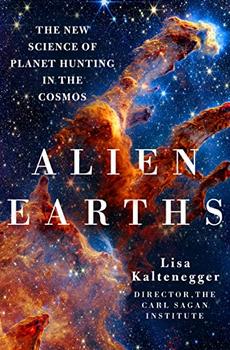Summary | Excerpt | Reviews | Beyond the Book | Readalikes | Genres & Themes | Author Bio

The New Science of Planet Hunting in the Cosmos
by Lisa KalteneggerChapter 1
At the Brink of Finding Life in the Cosmos
These worlds in space are as countless as all the grains of sand on all the beaches of the Earth. Each of those worlds is as real as ours and every one of them is a succession of incidents, events, occurrences which influence its future. Countless worlds, numberless moments, an immensity of space and time.
—Carl Sagan, Cosmos
The First Images from a New Spacecraft
The foam on my Portuguese espresso tastes a little bitter, but I hardly notice. For the past hour I've been staring at the images on my computer screen, a live feed from NASA's recently launched James Webb Space Telescope (JWST). The screen is dark now, and my own thoughts are wandering into that darkness, into what mysteries of the cosmos it will reveal.
Watching the flawless launch of the JWST on a late-December day in 2021, scientists from every continent focused intently on each step of the launch. From liftoff to observations, JWST had 344 single points of potential failure—each one of which alone could take down the entire system—so although we were relieved every time something went right, we knew that there were still hundreds of things that could go wrong.
With my eyes glued to NASA TV (and to our team's Slack channel, where colleagues in every time zone commented on the success of each step), I kept reminding myself to breathe—in and out, in and out. There was nothing any of us could do because the rocket had lifted off and was on its way to its final destination in space, a place about one million miles away called the second Lagrange point, L2. New York Times reporters Dennis Overbye and Joey Roulette described the image of JWST blasting off into space beautifully, as looking like "a tightly wrapped package of mirrors, wires, motors, cables, latches and willowy sheets of thin plastic on a pillar of smoke and fire." It also carried the dreams of thousands of scientists like me, hoping to catch a glimpse of the cosmos that had been beyond our reach—and our view—until now.
The JWST is the first telescope capable of capturing just enough light with its 21.3-foot (6.5-meter) mirror to explore the chemical composition of the atmosphere of other rocky worlds. Size is the key to collecting light. Imagine a bucket—the larger it is, the more rainwater it can catch in a downpour. The telescope's mirror operates the same way—the larger it is, the more light it can collect.
The cheering of the crew in the control room at the successful separation of the telescope from the rocket interrupted my thoughts. The final image from the launch broadcast was a close-up of the telescope drifting into the darkness of space, with a mesmerizing view of Earth's blue globe in the upper corner.
It would take months before the JWST successfully navigated each of the remaining hurdles as this beautiful bundle of mirrors, cables, and solar panels unfurled. After that it had to slowly cool to the freezing temperatures at which it could begin to operate.
It was only when examining the first signals that we proved we had beaten the odds. Having cleared every point of potential failure, this amazing telescope operated flawlessly, providing the first glimpses of a new way to see our cosmos—and a taste of the astonishing discoveries yet to come.
One of the most stunning images captured by the JWST is of the Eta Carinae Nebula, about seven thousand light-years away. This stellar nursery, where stars and new planets are just forming, looks like celestial art painted by a cosmic brush. But it's not just the birth of new worlds that the JWST is unveiling. An image shared with the public in July 2022 by President Joe Biden, a day before the first official NASA data release, revealed a time when the universe itself was in its infancy. In the JWST deep-field image, you can see thousands of galaxies scattered like glittering dots across the black canvas of space, contained in an area of the sky that, viewed from Earth, is about the size of a grain of sand. Their light took more than thirteen billion years to reach us, sending us a message from a time long before Earth was born. On its journey to our telescope, some rays were bent as they passed a massive cluster of galaxies. Matter and light interact, so this ancient light was warped into the beautiful arcs seen in the image, revealing relativity's pull over space and time.
Excerpted from Alien Earths by Lisa Kaltenegger. Copyright © 2024 by Lisa Kaltenegger. Excerpted by permission of St. Martin's Press. All rights reserved. No part of this excerpt may be reproduced or reprinted without permission in writing from the publisher.




Wisdom is the reward you get for a lifetime of listening when you'd rather have been talking
Click Here to find out who said this, as well as discovering other famous literary quotes!
Your guide toexceptional books
BookBrowse seeks out and recommends the best in contemporary fiction and nonfiction—books that not only engage and entertain but also deepen our understanding of ourselves and the world around us.